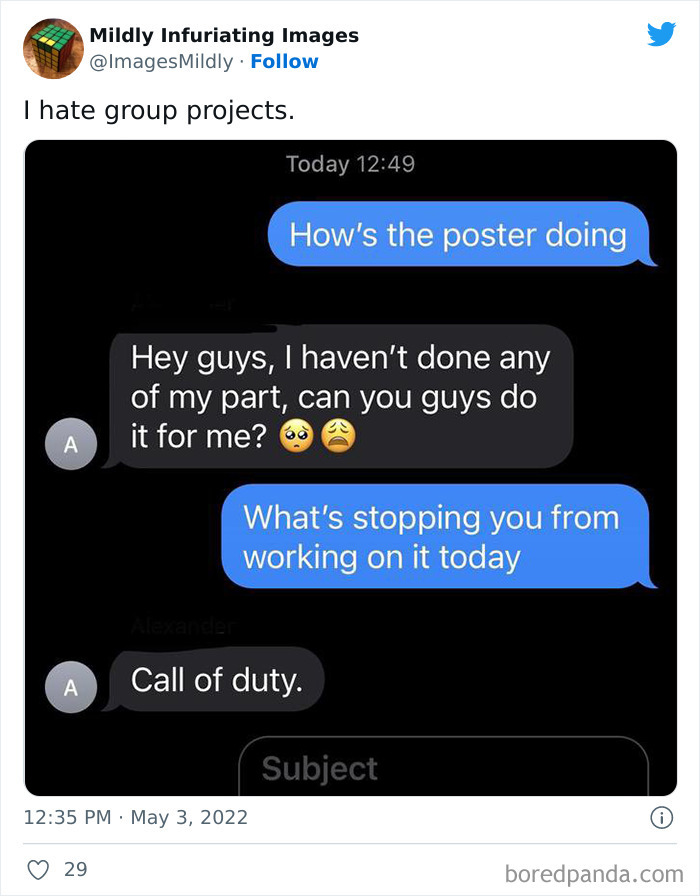Eating loudly, biting your nails in public, standing too close to another person in a line, and bringing pungent food to work are hands down among the most annoying things on planet Earth that should not exist. Yet, they still do, and from time to time, we all either fall victim or offender to them.
Having said that, some things are not so obviously infuriating yet they still feel uncomfortable. It’s even a whole phenomenon called “mild infuriation” that makes our arm hair stand on end and neurons go bananas.
While we can discuss what these particular things are, and they will surely vary from one person to another, there’s one social media account that needs no words. The Twitter page “Mildly Infuriating Images” does exactly what it sounds like and shares the most annoyance-inducing pics that induce this feeling.
Below we wrapped up the funniest, most spot-on and seriously angering examples, so scroll down!
#1
Image credits: ImagesMildly
#2
Image credits: ImagesMildly
#3
Image credits: ImagesMildly
Day by day, hour by hour we get annoyed by little things. It can be a sock left in the middle of the house by your roommate, a car that won’t start like a stubborn baby, or an unexpected email that sends your brain cells into rage mode. Do you wonder if our reaction to the world around us, the good and the bad of it, is something we can control? And if so, do we always succumb to the same frustrations?
#4
Image credits: ImagesMildly
#5
Image credits: ImagesMildly
#6
Image credits: ImagesMildly
According to Andrea Bonior, a therapist and mental health columnist, the term “frustrating” refers to one of the most common emotional labels we all use. Most often people use it to describe difficult times in life, from everyday annoyances to larger ruts that feel impossible to get out of.
Bonior argues that interestingly, frustration is likely to be the top layer of a feeling. “It speaks to a sense of stagnation or helplessness, an inability to make things happen in the way that someone wants.”
#7
Image credits: ImagesMildly
#8
Image credits: ImagesMildly
#9
Image credits: ImagesMildly
Moreover, the Merriam-Webster dictionary defines the state of frustration in part as “feeling discouragement, anger, and annoyance because of unresolved problems or unfulfilled goals, desires, or needs.”
“While this picture of frustration—the angry, sulking person who’s annoyed at the futility of their efforts—is a common one, with a little emotional exploration, we can see that an additional array of possible emotions can underlie frustration,” Bonior explained. According to her, the first step in getting through the experience in a healthy way is to figure out exactly what those deeper emotions are.
#10
Image credits: ImagesMildly
#11
Image credits: ImagesMildly
#12
Image credits: ImagesMildly
Among a wide array of deeper and underlying emotions, anger, anxiety or fear can be to blame. “A classic partner to frustration, anger is often what’s going on when you feel that something is thwarting you—and your ire is directed at that person or thing,” Bonior argues.
“You want to tear out your non-working dishwasher and set it aflame, or throw your frozen computer out the window? You want to scream at your teenager to get into the car already because you’ve told him four times to get his shoes on, and yet it still isn’t happening.”
#13
Image credits: ImagesMildly
#14
Image credits: ImagesMildly
#15
Image credits: ImagesMildly
In other cases, frustration may feel like a safer option to admit to than saying that we are anxious about or even in fear of something. But Bonior argues that “in these cases, what is really frustrating you is the fact that you want answers to something that’s scary: You’re looking for reassurance or certainty, and yet it’s not coming.”
#16
Image credits: ImagesMildly
#17
Image credits: ImagesMildly
#18
Image credits: ImagesMildly
At the moment of frustration, it may feel hard to control your emotions, but it would very helpful if you try. Taking a moment to pause and breathe can work wonders to ease the unnerving feeling. Focusing on your breath and breathing deeply from your diaphragm can help reduce negative feelings and ease any tension you may have in your body, according to a 2017 study.
#19
Image credits: ImagesMildly
#20
Image credits: ImagesMildly
#21
Image credits: ImagesMildly
#22
Image credits: ImagesMildly
#23
Image credits: ImagesMildly
#24
Image credits: ImagesMildly
#25
Image credits: ImagesMildly
#26
Image credits: ImagesMildly
#27
Image credits: ImagesMildly
#28
Image credits: ImagesMildly
#29
Image credits: ImagesMildly
#30
Image credits: ImagesMildly
#31
Image credits: ImagesMildly
#32
Image credits: ImagesMildly
#33
Image credits: ImagesMildly
#34
Image credits: ImagesMildly
#35
Image credits: ImagesMildly
#36
Image credits: ImagesMildly
#37
Image credits: ImagesMildly
#38
Image credits: ImagesMildly
#39
Image credits: ImagesMildly
#40
Image credits: ImagesMildly
#41
Image credits: ImagesMildly
#42
Image credits: ImagesMildly
#43
Image credits: ImagesMildly
#44
Image credits: ImagesMildly
#45
Image credits: ImagesMildly
#46
Image credits: ImagesMildly
#47
Image credits: ImagesMildly
#48
Image credits: ImagesMildly
#49
Image credits: ImagesMildly
#50
Image credits: ImagesMildly
Go to Source
Author: Gabija Palšytė

















































